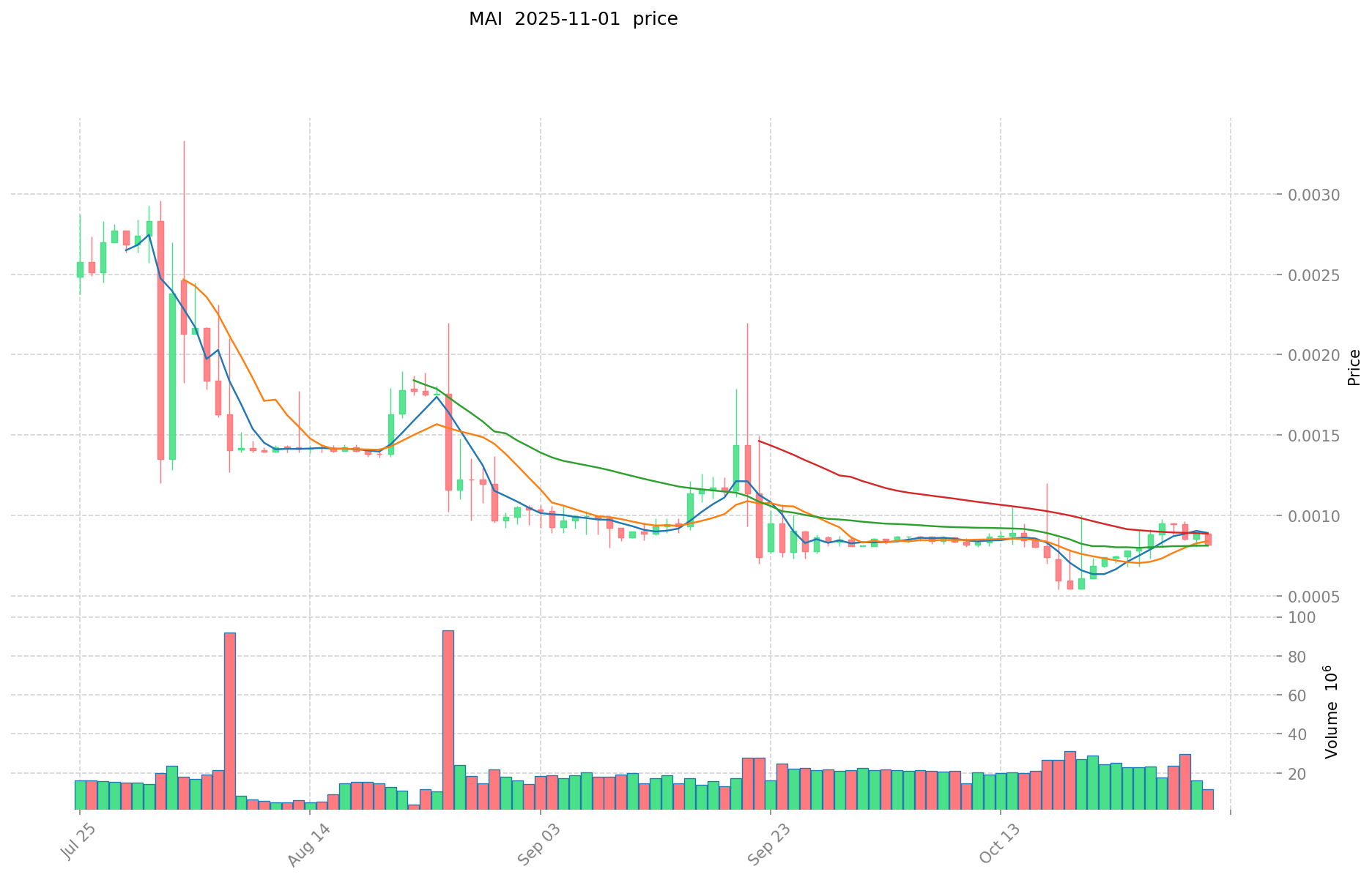MAI nedir: Devrim yaratan Multimodal AI Teknolojisinin incelenmesi


MAI'nin Konumu ve Önemi
2025 yılında MAI (MAI), yapay zekâyı merkeziyetsiz tahmin piyasalarıyla buluşturan yeni nesil bir platform olarak piyasaya sürüldü. Farklı piyasalarda daha bilinçli ve etkin, olay bazlı spekülasyon ihtiyacını karşılamayı hedefliyor.
Yapay zekâ destekli merkeziyetsiz tahmin platformlarının öncüsü olan MAI, spor, politika ve finansal öngörü alanlarında kilit rol oynuyor.
2025 itibarıyla MAI, tahmin piyasaları ve yapay zekâ destekli spekülasyon sektöründe yükselen bir oyuncu olarak, genişleyen kullanıcı kitlesi ve aktif bir geliştirici topluluğuna sahip. Bu makalede teknik mimarisi, piyasa performansı ve gelecekteki potansiyeli inceleniyor.
Kökeni ve Gelişim Süreci
Kuruluş Arka Planı
MAI, 2025 yılında tahmin piyasalarına ve spekülasyona katılımı dönüştürmek amacıyla geliştirildi. Yapay zekâ uygulamalarına ve merkeziyetsiz finans (DeFi) alanına artan ilginin ortasında, kullanıcılara daha gelişmiş öngörü ve piyasa katılım araçları sunmayı amaçladı.
MAI'nin lansmanı, spor bahisleri, politik öngörüler ve finansal spekülasyon piyasalarındaki katılımcılar için yeni fırsatlar yarattı.
Başlıca Kilometre Taşları
- 2025: Ana ağ lansmanı; tahmine dayalı analiz için gelişmiş makine öğrenimi algoritmalarının uygulanması.
- 2025: Gerçek zamanlı veri akışlarının ve güvenli akıllı kontratların entegrasyonu ile piyasa verimliliğinin artırılması.
MAI, geliştirme ekibi ve büyüyen topluluğunun desteğiyle teknolojisini, güvenliğini ve zincir üzerindeki uygulamalarını sürekli olarak iyileştiriyor.
MAI Nasıl Çalışır?
Merkeziyetsiz Kontrol
MAI, küresel olarak dağılmış bilgisayar (node) ağı üzerinde merkeziyetsiz şekilde işler ve hiçbir otorite tarafından kontrol edilmez. Bu nodelar, tahminleri ve piyasa sonuçlarını doğrulamak üzere iş birliği yaparak sistemin şeffaflığını ve dayanıklılığını artırır, kullanıcılara daha fazla özerklik sağlar.
Blockchain Temeli
MAI'nin blockchain'i, tüm piyasa oluşumlarını, tahminleri ve sonuçları kaydeden herkese açık, değiştirilemez bir dijital defterdir. İşlemler bloklar halinde gruplanır ve kriptografik hashler ile birbirine bağlanarak güvenli bir zincir oluşturulur. Herkes bu işlemleri görebilir ve aracıya gerek kalmadan güven ortamı sağlanır.
Adil Sistem Sağlama
MAI, muhtemelen piyasa sonuçlarını doğrulamak ve dolandırıcılığı önlemek için bir konsensüs mekanizması kullanır. Katılımcılar veri sağlayarak, sonuçları doğrulayarak veya ağ güvenliğini sağlayarak katkıda bulunabilir ve MAI token ödülleri kazanabilirler.
Güvenli İşlemler
MAI, işlemlerin güvenliği için açık anahtar kriptografisi kullanır:
- Özel anahtarlar (gizli şifre gibi), işlemleri imzalamak için kullanılır
- Açık anahtarlar (hesap numarası gibi), sahipliği doğrulamak için kullanılır
Bu mekanizma, fonların güvenliğini sağlarken kullanıcılara belirli bir gizlilik düzeyi sunar. Ayrıca, çoklu imza desteği veya merkeziyetsiz kimlik çözümleriyle entegrasyon gibi ek güvenlik önlemleri bulunabilir.
MAI'nin Piyasa Performansı
Dolaşımdaki Arz Görünümü
1 Kasım 2025 itibarıyla, MAI'nin dolaşımdaki arzı 150.000.000 token, toplam arzı ise 1.000.000.000 token’dır. Bu yapı, sabit arz modelini temsil eder.
Fiyat Dalgalanmaları
MAI, 7 Şubat 2025 tarihinde piyasanın yapay zekâ destekli tahmin platformlarına olan yoğun ilgisiyle $0,1 ile en yüksek seviyesine ulaştı.
En düşük fiyatı ise $0,0005374 ile 18 Ekim 2025 tarihinde kaydedildi; bu muhtemelen genel piyasa düzeltmeleri veya projeye özgü durumlar nedeniyle gerçekleşti.
Bu dalgalanmalar, piyasa duyarlılığını, benimseme eğilimlerini ve yapay zekâ-tahmin piyasası sektörünü etkileyen dışsal faktörleri gösteriyor.
MAI'nin güncel piyasa fiyatını görüntülemek için tıklayın

Zincir Üzeri Metrikler
- Günlük İşlem Hacmi: $10.165,24 (ağdaki işlem yoğunluğunu gösteriyor)
- Aktif Adresler: 29 (kullanıcı etkileşimini yansıtır)
MAI Ekosistemi: Uygulamalar ve Ortaklıklar
Temel Kullanım Alanları
MAI ekosistemi birçok uygulamayı destekler:
- Tahmin Piyasaları: Spor, politika ve finans alanında olay bazlı spekülasyon için yapay zekâ odaklı platformlar.
- Merkeziyetsiz Finans: Gerçek zamanlı veri ve güvenli akıllı kontrat entegrasyonu ile verimli piyasa operasyonları.
Stratejik Ortaklıklar
MAI, teknolojik kabiliyetlerini ve piyasa etkisini artırmak için stratejik ortaklıklar kurdu. Bu iş birlikleri, MAI ekosisteminin büyümesinde sağlam bir temel sunuyor.
Tartışmalar ve Zorluklar
MAI'nin karşılaştığı başlıca zorluklar:
- Teknik Engeller: Yapay zekâ odaklı tahminlerin doğruluğu ve güvenilirliği.
- Regülasyon Riskleri: Finansal düzenleyicilerin yapay zekâ destekli tahmin piyasalarını denetleme olasılığı.
- Rekabet Baskısı: Diğer yapay zekâ-blokzincir hibrit platformların ortaya çıkması.
Bu sorunlar, topluluk içinde ve piyasada tartışmalar yaratıyor ve MAI'nin sürekli yenilikçi kalmasını sağlıyor.
MAI Topluluğu ve Sosyal Medya Atmosferi
Topluluk Coşkusu
MAI topluluğu dinamik; yapay zekâ destekli tahmin piyasalarına yönelik ilgi hızla artıyor. X'te MAI ile ilgili paylaşımlar ve etiketler, özellikle piyasa olayları ve yeni özellik duyurularında öne çıkıyor.
Sosyal Medya Algısı
X'teki algı çeşitlilik gösteriyor:
- Destekçiler, MAI'nin yapay zekâ ile merkeziyetsiz tahmin piyasalarını bir araya getiren yenilikçi yaklaşımını övüyor.
- Eleştirmenler, piyasa manipülasyonu olasılığı veya yapay zekâ tahminlerinin güvenilirliği konusunda endişelerini dile getiriyor.
Son dönemdeki trendler, tahmin piyasalarında yapay zekâ-blokzincir entegrasyonuna artan bir ilgiye işaret ediyor.
Gündemdeki Konular
X kullanıcıları, MAI'nin geleneksel bahis piyasalarındaki potansiyel etkisini, finansal spekülasyonda yapay zekânın rolünü ve adil, şeffaf yapay zekâ tahminlerinin sağlanmasındaki zorlukları tartışıyor.
MAI Hakkında Daha Fazla Bilgi Kaynağı
- Resmi Web Sitesi: Özellikler, kullanım alanları ve en güncel gelişmeler için [MAI'nin resmi web sitesini] ziyaret edin.
- Whitepaper: MAI'nin whitepaper'ı, teknik mimarisini, hedeflerini ve yapay zekâ destekli tahmin piyasalarına dair vizyonunu ayrıntılı olarak açıklar.
MAI Gelecek Yol Haritası
- 2026: Daha doğru piyasa tahminleri için gelişmiş yapay zekâ algoritmalarının kullanıma sunulması.
- Ekosistem Hedefleri: Farklı sektörlerde geniş tahmin piyasası çeşitliliğinin desteklenmesi.
- Uzun Vadeli Vizyon: Yapay zekâ destekli merkeziyetsiz tahmin piyasalarının lider platformu olmak.
MAI'ye Nasıl Katılabilirsiniz?
- Satın Alma Kanalları: MAI'yi Gate.com üzerinden satın alabilirsiniz.
- Saklama Çözümleri: MAI token'larınızı güvenli cüzdan çözümleriyle saklayın.
- Yönetime Katılım: MAI yönetim platformu aracılığıyla topluluk karar mekanizmalarına katılın.
- Ekosistem Geliştirme: MAI'nin tahmin piyasası ekosistemine katkı sağlamak için geliştirici dokümantasyonuna erişin.
Özet
MAI, yapay zekâyı blockchain teknolojisiyle birleştirerek tahmin piyasalarında şeffaflık, güvenlik ve verimli spekülasyon sunuyor. Aktif topluluğu, zengin kaynakları ve yenilikçi yaklaşımıyla kripto para sektöründe öne çıkıyor. Regülasyon belirsizlikleri ve teknik zorluklara rağmen MAI'nin yenilikçi vizyonu ve belirgin yol haritası, onu merkeziyetsiz yapay zekâ destekli tahmin piyasalarının geleceğinde önemli bir aktör konumuna taşıyor. İster yeni katılımcı olun, ister deneyimli bir oyuncu, MAI'yi izlemek ve ekosisteme katılmak değerli olacaktır.
Sıkça Sorulan Sorular
MAI enfeksiyonuna ne sebep olur?
MAI enfeksiyonu, genellikle bağışıklık sistemi zayıf kişilerde görülen Mycobacterium avium complex (MAC) bakterisiyle oluşur. Genellikle çevresel bakterilerin solunması veya yutulmasıyla bulaşır.
MAI tedavi edilmeli mi?
Evet, MAI genellikle tedavi gerektirir; özellikle fibrokaviter akciğer hastalığında. Komplikasyonları önlemek için antibiyotikler standart tedavidir.
MAI'nin sebebi nedir?
MAI, genellikle bağışıklık sistemi zayıf bireylerde görülen Mycobacterium avium complex (MAC) bakterisiyle oluşur. Bakteri solunarak veya yutularak yayılır.
MAI enfeksiyonu bulaşıcı mı?
MAI enfeksiyonu genellikle insanlar arasında bulaşıcı değildir. Daha çok su, toprak ve toz gibi çevresel kaynaklardan edinilir.

WhiteBridge Ağı (WBAI): İnsan-Veri Zekası için AI Destekli Güven Katmanı

$LAB (LAB) Son Güncelleme

Bluwhale nedir?

GTAI nedir: Üretici Metin Yapay Zekâ Teknolojisinin Geleceği Üzerine Bir İnceleme

Kripto Rakip Analizi, 2025’te Pazar Payının Artırılmasına Nasıl Katkı Sağlar?

xStocks: 2025'te Hisse Senedi Ticareti için Merkeziyetsizlik Geleceği

Web3 Teknolojisinin Anlamı Üzerine Bir İnceleme

FWOG Nedir: Merkeziyetsiz Finansın En Son Yeniliğini Anlamak İçin Detaylı Bir Rehber

Web3 Oyunlarının İncelenmesi: Castle Age'deki Mekanikler ve Yenilikler

Merkeziyetsiz Uygulamaları Anlamak: Web3’e Dair Kapsamlı Bir Genel Bakış







